Attracting Birds
NEW! Plant 70% native trees and other plants to support and sustain habitat in your own yard, patio, or porch. Download this helpful list Tree and Plant List.
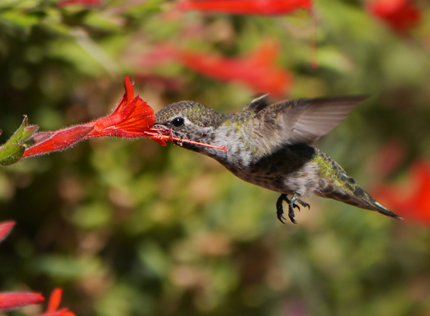
Anna's Hummingbird at California Fuchsia
Article and Plant List by Denise Kelly
Little things really do add up. And this is especially true for bird habitats. You can make a big difference to local and migrating birds by making your garden a more bird-friendly place, and you don’t have to sacrifice garden aesthetics to do so. The big three for birds are also the big three for lots of other wildlife: shelter, things to eat, and clean water. Native plants are uniquely suitable as habitat because our native insects, including important pollinators, have evolved with our native plant species.
Insects are a very important piece in the diet of birds, especially migratory and nesting birds, because of their high protein content. So our native plants supply food for our native insects, which in turn supply food for birds, and native plants also provide all sorts of seeds and berries in addition to cover and nesting materials.
It is increasingly evident that what we plant, and where those plants are, make a huge difference. Yes, birds can fly from place to place seeking food and water. But they can only fly for so long before they need to stop, safely rest for a while, have some water, and maybe some food. They also need safe nesting sites, nesting materials, and places to roost. They have evolved with our native plant species and recognize them even in the fragmented habitats of suburbia, so it’s important for gardeners to provide little pieces of heaven for our wildlife.
Re-Imagining Your Lawn
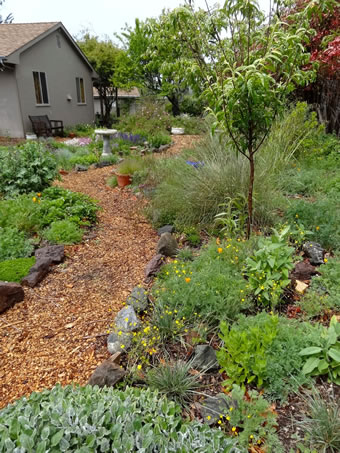
From lawn to garden – photo by Suzi Katz
There has been a small but growing national movement to shift away from our thirsty, weed- and insect-free lawns—and for good reason. Perhaps it is a concern for our increasing loss of wildness and accompanying loss of wild things, or perhaps it is also driven by the desire to have a different sort of yard- a garden that wildlife is drawn to and doesn’t look like it came in a box. There are many plant choices if one likes the look of a green sward: small meadows with a mixture of grasses and forbs; tough, short-stature sedges that stay bright green all year; or native bunchgrasses with lovely seedheads that move beautifully in the breeze.
The non-lawn is a different look indeed, and takes some getting used to for some of us. But imagine not having to use high-nitrogen fertilizers, or pesticides to kill the lawn grubs that raccoons roll up the neighborhood turf for, and eliminating air and noise polluting lawn mowers. It takes imagination and a certain relaxing of what looks “nice” in a space to do away with a lawn. It also takes a bit more gardening knowledge about how to care for non-turfgrass species. But the results—priceless.
Bringing Nature Home and The California Wildlife Habitat Garden
For incredible inspiration, read Douglas Tallamy’s landmark book, Bringing Nature Home. He articulates very simple concepts, “…the wild creatures we enjoy and would like to have in our lives will not be here in the future if we take away their food and the places they live.” Indeed, native creatures have evolved with native plants. Some exotic plants might be palatable to our native plant-eaters, but are often not recognized as such. And all creatures need space; it would be nice to share our spaces more kindly by re-planting some of the native plants that birds and other wildlife easily recognize as food and shelter.
Tallamy’s first chapter, “Restoring Natives to Suburbia,” begins by talking about the many joys and satisfactions of gardening. And then this incredible paragraph: “But now, for the first time in its history, gardening has taken a role that transcends the needs of the gardener. Like it or not, gardeners have become important players in the management of our nation’s wildlife. It is now within the power of individual gardeners to do something we all dream of doing: to ‘make a difference.’ In this case the ‘difference’ will be to the future of biodiversity, to the native plants and animals of North America and the ecosystems that sustain them.” This is a completely refreshing, compelling, and inspiring take on a “sense of place.”
Another wonderful resource is local author Nancy Bauer, author of The California Wildlife Habitat Garden. Bauer reminds us, “While experts rarely agree on any one explanation for the decline of wildlife species, the rapid loss of habitat… is a chief concern. Protected wilderness, which is a very small percentage of our total available land, provides only fragmented and isolated islands of habitat.” This book has very useful plant lists and appendices as well as inspiring photos from local and Bay Area gardens.
Birds tend to linger where they find food, water, and shelter. Rather than fly from place to place looking for one of these three critical elements, they can settle in for “one-stop shopping” and tend to activities such as attracting a mate and building a nest. So if your garden provides these things you will be treated to beautiful birds and beautiful songs in your very own yard. Not coincidentally, these are the same things that we humans find attractive and soothing in a garden: the sound of water, the sense of shelter provided by trees, and a place to rest and have a snack, perhaps with others like us.
Invasive Plant Species
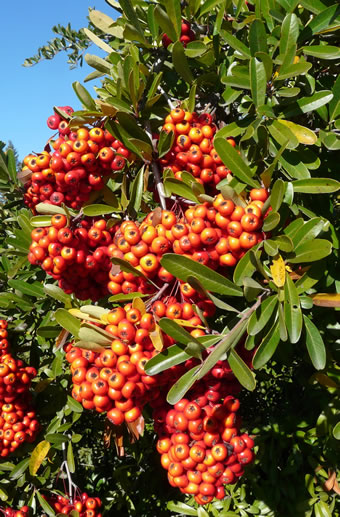
Pyracantha, an invasive species
Invasive exotic plants are of special concern because of the native species that they displace. Many invasive species are escaped garden ornamentals, pasture grasses, or wood products trees. Some of the top invasives in Sonoma County are acacias (Acacia spp.), tree of heaven (Ailanthus altissima), bluegum (Eucalyptus globulus), privets (Ligustrum spp.), poplars (Populus spp.), ornamental willows (Salix spp.), Chinese wisteria (Sesbania punicea), and cherry plum (Prunus cerasifera).
Invasive shrub species include privets, butterfly bush (Buddleia davidii), French broom (Genista monspessulana), Himalayan blackberry (Rubus discolor), firethorn (Pyracantha spp.), silver cotoneaster (Cotoneaster pannossus), and gorse (Ulex europaeus).
Invasive grasses and forbs include giant reed (Arundo donax), tall fescue (Festuca arundinacea), veldtgrasses (Ehrharta spp.) pampas grasses (Cortaderia spp.), quaking grass (Briza maxima), star thistle (Centaurea solstitialis), bull thistle (Cirsium vulgare), and Japanese knotweed (Fallopia japonica).
Starting a Habitat Garden Design
The same basic principles apply to beginning all home gardens, but particularly with a habitat-focused garden; start small and have a plan in mind. That phrase “sense of place” comes back here—have a look at your neighborhood and what native plants are still found nearby and start there. Design to grow the right plant in the right place, letting the light and water needs as well as the ultimate size of a plant determine your palette and placement.
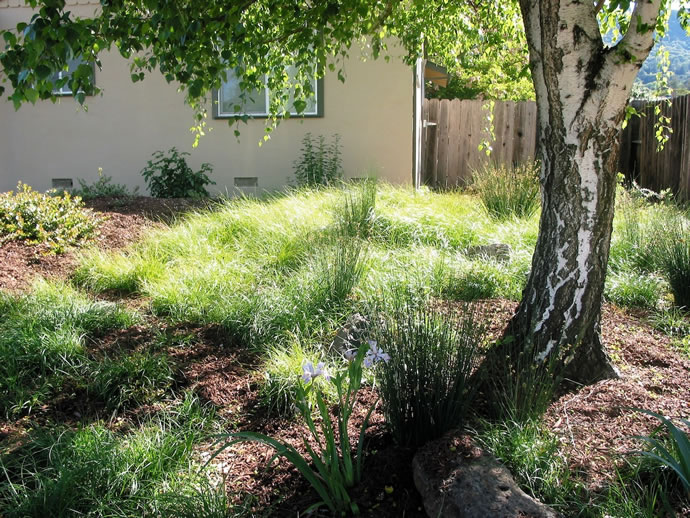
Carex pansa lawn - designed by Alrie Middlebrook
Pollinators and birds are most drawn to sweeps of plants, and birds seek cover with some intermixing of tall and short plants. These planting schemes goes well with modern design as well as prairie/natural habitat sorts of design and can be incorporated into existing landscapes with a good design eye. It may be that some of us will need to re-think the native = weedy equation, and that’s where photos of beautiful native gardens are especially helpful. Planting even a few native plants will be very beneficial to both birds and pollinators, reducing the island effect of habitat fragmentation.
Cover, or shelter, is critical for birds. Species that prefer higher sites (trees and tall shrubs) are raptors, crows, and mockingbirds. Mid-level shrubs attract finches, sparrows, chickadees, and wrens; lower plants provide cover for quail, towhees, and juncos. And don’t forget the cavity nesters such as bluebirds, brown creepers, woodpeckers, flickers, and wood ducks. If you can safely leave a tree where a bird has started to excavate a cavity in, please do so. Cavity nesting birds are some of the hardest hit when it comes to habitat loss.
Soils
Remember that healthy soil grows healthy plants, so it’s a good idea to treat it like the home that it is by using natural materials and avoiding inadvertently compacting it. Some suburban garden soils are actually subsoils, wherein all the topsoil containing organic matter was stripped off during the construction process to reveal a more compactable subsoil with very little organic matter. Great for construction, not so great for a garden soil. Or you may have a mix of native and off-site soils, a “mongrel” soil, another situation that will require some amending or positive drainage to accommodate native plants.
Water and Watering
Irrigating gardens, especially natives, is not a simple matter, and another area where we may need to be more involved with our landscape. Although native plants in the wild do not receive supplemental irrigation and mostly do just fine, the right amount of water for native plants in the garden is another story for several reasons: the increased heat and evaporative effects of nearby hard surfaces, soils that are no longer native (see above), altered drainage patterns, less distance between plants, increased foot traffic, dust, mulching, and the desire to see plants that look “good” all year long.
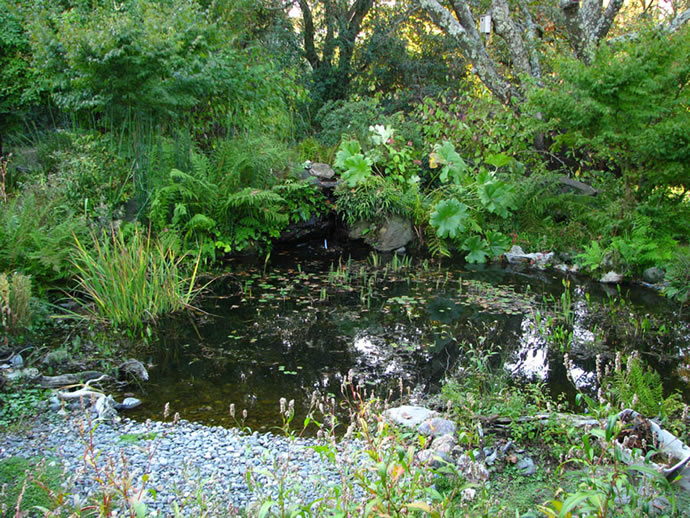
Dragonfly pond - photo by Dave Biggs
Native plants do best with irrigation schemes that most closely mimic the natural rainfall pattern of where they are native. Here in Sonoma County, that generally means plentiful rainfall from about October through early April. In recent years, we have received far less water than normal, so most native plants would do well to receive some supplemental water both during both winter and early spring. Grasses, sedges, rushes, and forbs may thrive with some extra water during hot spells. Woody plants, especially ceanothus and manzanitas, do not do well with wet feet or water contacting the woody stem. It’s best to group plants, especially natives, according to their water requirements.
A source of clean water is an important part of truly most any garden, but especially a garden wanting to be an invitation for birds and wildlife. A pond can be a lovely component—it will attract all kinds of insects and birds—and if you have the space, you will be treated to dragonflies, water skimmers, and all sorts of bird visitors. But not every garden has that sort of space. Birdbaths with clean water are very useful for small birds especially, or perhaps a fountain with a slow enough trickle for birds to wade and splash about in. The sound of trickling water can be very soothing; fountain pumps can be on a timer and even solar powered.
Pollinators
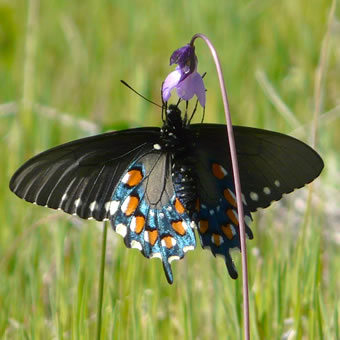
Pipevine Swallowtail
Both non-native honeybees and native bees and other pollinators were more abundant when agriculture was practiced on a smaller scale than what we typically see today. In areas of California where small farms are present, with diverse habitat nearby and perhaps even hedgerows, wild native bees and bumblebees still pollinate all the crops, according to the Xerces Society’s Pollinator Conservation Program. Native bees and bumblebees provide significant pollination on mid-sized farms bordered by diverse landscapes, but not so much on large-scale farms.
Loss of habitat and pesticides are the likely reasons for loss of native pollinators. Commercial honeybees have filled this pollination gap for decades, but they are now in trouble due of Colony Collapse Disorder. Janet Aird, in “The California Agricultural Pollinator Project” explains, “The California Agricultural Pollinator Project” is a collaboration among several organizations, including The Xerces Society for Invertebrate Conservation in Portland, OR, a non-profit organization named for the extinct butterfly, the Xerces Blue, that works to protect wildlife and help farm production by bringing bee habitat back to the farm. These organizations aim to bring wild bees back.”
Mace Vaughan is an entomologist who has led the Xerces Society’s Pollinator Conservation Program since 2003, and also serves as the joint pollinator conservation specialist for the USDA’s Natural Resources Conservation Service. Vaughan says, “The heart of this project is to get pollinator habitat into the ground and protect it. We’re asking farmers to plant a diverse habitat, a whole new crop on their land.” There are some beneficial side effects to these diverse plantings: they do indeed attract pollinators as well as songbirds and insects that eat crop pests.
It’s nice to remember that you don’t necessarily have to drive to connect with nature- you can do it at home with native plants and wildlife. —“Nature is not a place to visit. It is home.” Gary Snyder
The following plant list is by no means exhaustive but contains many plants that are beneficial to birds and other wildlife, including pollinators. Choosing plants that grow well in your area without a lot of supplemental input of water and other resources will give you more time to watch the birds enjoying your garden.
Plant List
Plant List.xls [38 KB Excel file]
Links
Audubon Plants for Birds
Plants recommended for our specific area, sorted by zip code & includes notation on which birds are attracted.
Audubon.org/plantsforbirds
Audubon Creating Bird-Friendly Communities
Audubon is committed to transforming our communities into places where birds flourish.
Audubon Bird-Friendly Communities
Author Nancy Bauer’s website
www.calwildgarden.com
California Native Plant Society Habitat Gardening
http://www.cnps.org/cnps/grownative/habitat/
Hummingbirds at home
An Audubon citizen science project; great for families to learn to monitor hummingbirds and note which plants they feed on.
hummingbirdsathome.org
National Wildlife Federation Garden for Wildlife
http://www.nwf.org/How-to-Help/Garden-for-Wildlife/Create-a-Habitat.aspx
UCB Urban Bee Lab
http://www.helpabee.org/
Starting your own native bee sanctuary
http://www.pacifichorticulture.org/articles/starting-your-own-native-bee-sanctuary/
Native bees
Native bees are a rich natural resource in urban California gardens
http://ucanr.org/repository/CAO/landingpage.cfm?article=ca.v063n03p113&fulltext=yes
How to attract and maintain pollinators in your garden
http://anrcatalog.ucdavis.edu/pdf/8498.pdf
Native Bees, Native Plants, and Crop Pollination in California
http://nature.berkeley.edu/kremenlab/Articles/Native%20Bees,%20native%20plants,%20and%20crop%20pollination%20in%20California.pdf
Yardmap
An interactive program supported by Cornell; map your yard & gain tips on appropriate plants; includes pollinator guide.
Yardmap.org
Find us on Facebook 
It's Nesting Season: trim trees in the Fall!.
Amazon Smile: donate to Madrone when you shop
Birding Quiz - test your skills.
Leaves Newsletter
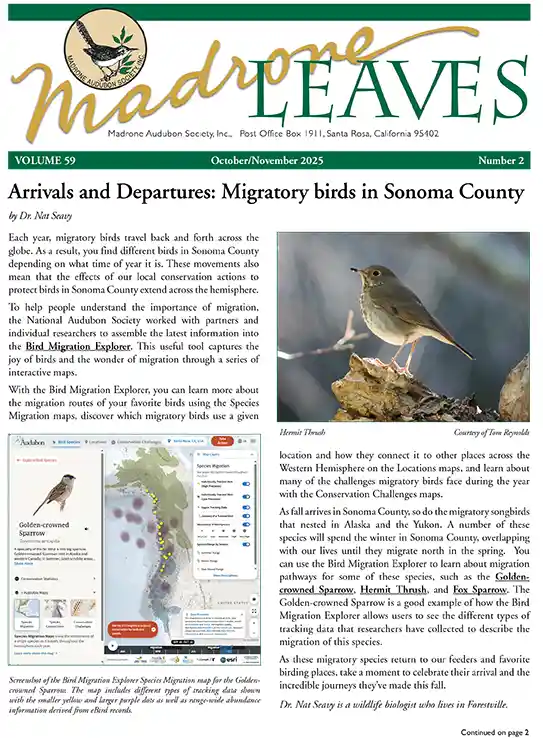
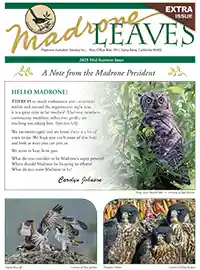
Carved Bird Pins
In the 1970s, member Tom Olds hand-carved bird pins and sold them to raise money for Madrone Audubon. More